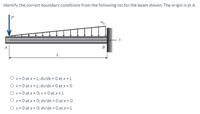
Elements Of Electromagnetics
7th Edition
ISBN: 9780190698614
Author: Sadiku, Matthew N. O.
Publisher: Oxford University Press
expand_more
expand_more
format_list_bulleted
Question

Transcribed Image Text:Identify the correct boundary conditions from the following list for the beam shown. The origin is at A.
B
L
O v = 0 at x = L; dv/dx = 0 at x = L
O v = 0 at x = L; dv/dx = 0 at x = 0
O v = 0 at x = 0; v = 0 at x = L
O v = 0 at x = 0; dv/dx = 0 at x = 0
O v = 0 at x = 0; dv/dx = 0 at x = L
Expert Solution
This question has been solved!
Explore an expertly crafted, step-by-step solution for a thorough understanding of key concepts.
This is a popular solution
Trending nowThis is a popular solution!
Step by stepSolved in 2 steps with 2 images

Knowledge Booster
Learn more about
Need a deep-dive on the concept behind this application? Look no further. Learn more about this topic, mechanical-engineering and related others by exploring similar questions and additional content below.Similar questions
- answer this ; The second moment of area employed in the equation to calculate maximum shear stress can be calculated as ??= ( units : ??4 )arrow_forwardThe person who answered this previously used sin and cos-please use geometry for example 3,4,5 triangles things of that nature. Thanksarrow_forwardFind the Nominal force, N in kilo Newtons (kN). What is the shear force, V in kilo Newtons (kN). Find the bending moment, M in kilo Newton metres (kNm).arrow_forward
- A cross-section of a beam is shown in Figure Q2. If the shear force in this section is V determine the value and the location of the maximum shear stress in the section. In Figure Q2, a = 68 mm and the origin of the coordinate system is at centroid of the cross section. y= A Z= a I₂ = S = AY mm; Figure Q2 Answer The vertical coordinate (y-coordinate; the y-axis serves as the axis of symmetry of the cross- section.) and horizontal coordinate (z-coordinate) of the location where the maximum shear stress occurs in the section are mm; O 4a Tmax= The vertical distance from the location where the maximum shear stress occurs in the section to the bottom side (AB) of the cross section can be calculated as Distance = mm B Second moment of area The second moment of area employed in the equation to calculate maximum shear stress can be calculated as Shear stress a (units : mm¹ ) First moment of area The first moment of area employed in the equation to calculate maximum shear stress can be…arrow_forwardQuestion 13 Use the diagram shown above. Given • D₁ = 9 ft D₂=7 ft D₂ 3 D3-4 ft • W = 100 #/ft P = 800 # D. 1 D₂ X W P Solve for the internal moment at X. Note: Enter the numerical value only for your calculation results. You'll be asked to specify the unit for your calculation result in the following question. (This is due to Canvas' lack of ability to require units for calculation question.)arrow_forwardWhen a beam section is subjected to a shear load, a shear stress distribution is developed on the section. The distribution of the shear stress is not linear. Elasticity theory can be used to calculate the shear stress at any point. However, a simpler method can be used to calculate the average shear stress across the width of the section, a distance y above or below the neutral axis. The average VQ shear stress is given by T = Here V is the shear It force on the section, I is the moment of inertia of the entire section about the neutral axis, and t is the width of the section at the distance y where the shear stress is being calculated. Q is the product of the area of the section above (or below) y and the distance from the neutral axis to the centroid of that area (Figure 1). In short, Q is the moment of the area about the neutral axis. I Figure 1 of 1 An I-beam has a flange width b = 250 mm, height h = 250 mm, web thickness tw = 9 mm, and flange thickness tf = 14 mm. Use the…arrow_forward
arrow_back_ios
arrow_forward_ios
Recommended textbooks for you
 Elements Of ElectromagneticsMechanical EngineeringISBN:9780190698614Author:Sadiku, Matthew N. O.Publisher:Oxford University Press
Elements Of ElectromagneticsMechanical EngineeringISBN:9780190698614Author:Sadiku, Matthew N. O.Publisher:Oxford University Press Mechanics of Materials (10th Edition)Mechanical EngineeringISBN:9780134319650Author:Russell C. HibbelerPublisher:PEARSON
Mechanics of Materials (10th Edition)Mechanical EngineeringISBN:9780134319650Author:Russell C. HibbelerPublisher:PEARSON Thermodynamics: An Engineering ApproachMechanical EngineeringISBN:9781259822674Author:Yunus A. Cengel Dr., Michael A. BolesPublisher:McGraw-Hill Education
Thermodynamics: An Engineering ApproachMechanical EngineeringISBN:9781259822674Author:Yunus A. Cengel Dr., Michael A. BolesPublisher:McGraw-Hill Education Control Systems EngineeringMechanical EngineeringISBN:9781118170519Author:Norman S. NisePublisher:WILEY
Control Systems EngineeringMechanical EngineeringISBN:9781118170519Author:Norman S. NisePublisher:WILEY Mechanics of Materials (MindTap Course List)Mechanical EngineeringISBN:9781337093347Author:Barry J. Goodno, James M. GerePublisher:Cengage Learning
Mechanics of Materials (MindTap Course List)Mechanical EngineeringISBN:9781337093347Author:Barry J. Goodno, James M. GerePublisher:Cengage Learning Engineering Mechanics: StaticsMechanical EngineeringISBN:9781118807330Author:James L. Meriam, L. G. Kraige, J. N. BoltonPublisher:WILEY
Engineering Mechanics: StaticsMechanical EngineeringISBN:9781118807330Author:James L. Meriam, L. G. Kraige, J. N. BoltonPublisher:WILEY

Elements Of Electromagnetics
Mechanical Engineering
ISBN:9780190698614
Author:Sadiku, Matthew N. O.
Publisher:Oxford University Press

Mechanics of Materials (10th Edition)
Mechanical Engineering
ISBN:9780134319650
Author:Russell C. Hibbeler
Publisher:PEARSON

Thermodynamics: An Engineering Approach
Mechanical Engineering
ISBN:9781259822674
Author:Yunus A. Cengel Dr., Michael A. Boles
Publisher:McGraw-Hill Education

Control Systems Engineering
Mechanical Engineering
ISBN:9781118170519
Author:Norman S. Nise
Publisher:WILEY

Mechanics of Materials (MindTap Course List)
Mechanical Engineering
ISBN:9781337093347
Author:Barry J. Goodno, James M. Gere
Publisher:Cengage Learning

Engineering Mechanics: Statics
Mechanical Engineering
ISBN:9781118807330
Author:James L. Meriam, L. G. Kraige, J. N. Bolton
Publisher:WILEY